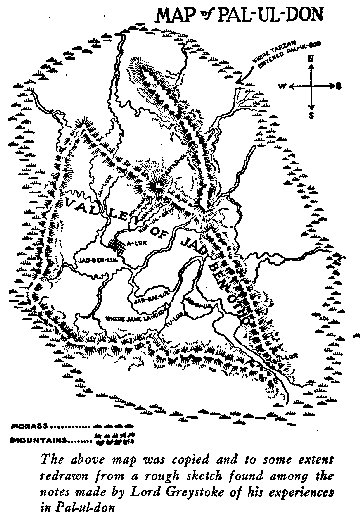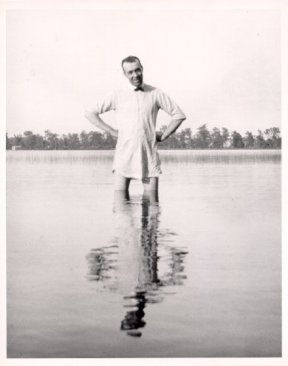Area
Although Mr. Burroughs
has not included a scale with his map my extrapolating estimate is that
Pal-ul-don stretches approximately 70 miles north-south and 50 miles east-west
for an area of approximately 3500 square miles.

 Landforms
The land of Pal-ul-don
contains a wide range of landforms fringed by an almost-impenetrable morass
beyond which lies a vast thorn desert.
Landforms
The land of Pal-ul-don
contains a wide range of landforms fringed by an almost-impenetrable morass
beyond which lies a vast thorn desert.
“[Tarzan] made
his way toward the southwest, crossing, after the most appalling hardships,
a vast waterless steppe covered for the most part with dense thorn...”
“…after weeks of
arduous effort he succeeded in finding a spot where he might cross the
morasses – a hideous stretch infested by venomous snakes and other larger
dangerous reptiles.”
“ …he realized
why it was that for perhaps countless ages this territory had defied …
the heroic races of the outer world.”
“When at last he
stood upon firm ground after crossing the morasses… Here were precipitous
mountains, well-watered plateaus, wide plains, and vast swampy morasses…”
(pp. 5-6)

One of the few
men to have crossed the morasses of Pal-ul-don
 Flora
The vegetation is typical
for this latitudinal location in interior Africa.
Flora
The vegetation is typical
for this latitudinal location in interior Africa.
“…the country was
rich in game animals and birds and fish, in fruit and the countless other
forms of vegetable life…” (p. 8)
 Fauna
There are remarkable animals
native to Pal-ul-don which appear nowhere else on earth – at least in recent
times. The encompassing morass is teeming with insect, amphibian, saurian
and reptilian life. In addition to the usual African crocodiles, serpents,
and lizards there are swarms of prehistoric species.
Fauna
There are remarkable animals
native to Pal-ul-don which appear nowhere else on earth – at least in recent
times. The encompassing morass is teeming with insect, amphibian, saurian
and reptilian life. In addition to the usual African crocodiles, serpents,
and lizards there are swarms of prehistoric species.
The most prominent
species of prehistoric life in Pal-ul-don is the gryf – a carnivorous
version of the triceratops – a dinosaur believed to have been extinct for
over 50 million years. The gryf wanders over the entire area but appears
to have staked out its mating grounds in the gorge, Kor-ul-gryf, situated
in the northern part of the main Valley of Jad-ben-otho.
“’This thing that
you call a gryf is a triceratops and it has been extinct for hundreds of
thousands of years…’ Instantly the great bony hood over the neck was erected
and a mad bellow rolled upward from the gigantic body. Full twenty feet
at the shoulder the thing stood, a dirty slate-blue in color except for
its yellow face with the blue bands encircling the eyes, the red hood with
the yellow lining and the yellow belly. The three parallel lines of bony
protuberances down the back gave a further touch of color to the body,
those following the lines of the spine being red, while those on either
side are yellow. The five and three-toed hoofs of the ancient horned dinosaurs
had become talons in the gryf, but the three horns, two large ones above
the eyes and a median horn on the nose, had persisted through the ages.”
Also roaming the area
are two dangerous lion-like beasts. The ja is identical to the modern
day African lion except for its brown, leopard-spots. The second cat –
the jato - appears to be a hybrid of a sabre-tooth tiger and a lion.
This vicious yellow-and-black striped predator is armed with long knifelike
canine teeth curving down from its upper jaw.
Humanoid Pithecanthropi
Races
Ho-don (the tailed,
white, hairless race)
“…it walked upon
two feet and was hairless except for a black thatch upon its head; its
arms were well shaped and muscular; its hands powerful and slender with
long tapering fingers and thumbs reaching almost to the first joint of
the index fingers. Its legs too were shapely but its feet departed from
the standards of all races of men, except possibly a few of the lowest
races, in that the great toes protruded at right angles from the foot.
“[The features]
were strong, clean cut, and regular – features that would have attracted
attention for their masculine beauty in any of the great capitals of the
world. But was this thing a man? … for beneath the loin cloth of black
fur that girdled its thighs there depended a long hairless, white tail.”
(p. 2)
In addition to animal
skin loincloths, the females of the species wear gold breastplates and
both sexes wear leather belts, knife sheaths and pouches adorned with gold
and gemstones.
The Ho-don are culturally
the most advanced of the humanoids. They live as organized societies in
scattered clusters of settlements which are hand carved from limestone
hillocks. Each city has a king while the king of the largest city A-lur
is recognized as supreme ruler of all Ho-dans.
A prominent feature
of the ritualistic Ho-don religion is that of human sacrifice to the tailless
god, Jad-Ben-Otho.
Waz-don (the
tailed, black, hair-covered race)
The Waz-don are essentially
the same as the Ho-don in appearance and accouterment except for
the black hair which covers most of the body. The hair cover is longer
in men, while that which covers the women is shorter and sleeker – almost
like seal fur.
Unlike the Ho-don,
the Waz-don are organized in smaller independent tribes which dwell either
in arboreal villages in the forests, or more often, in caves that they
have carved into the sheer cliffs of the mountains which surround the Valley
of Jad-Ben-Otho. They practice limited agriculture employing a spear-like
digging implement. Each tribe has its own gund (chief).
Their religious belief
centers around the creator Jad-Ben-Otho (The Great God). The Waz-don believe
that god has a tail, the Ho-don believe that he is tailless – and each
race is prepared to fight to the death for their beliefs.
Waz-ho-don
(the hybrid race – interbred Ho-don and Waz-don)
Since Tarzan made
no contact with this race we have no description of them. We can only assume
that they have features common to both Ho-don and Waz-don – with whom they
share a common language and religious belief. They are apparently politically
autonomous.
Tor-o-don (beast-like
man)
This humanoid species
resembles some form of great ape. They are covered with coarse black hair
and possess a prehensile tail. The Tor-o-don's size, weight and strength
would match that of a gorilla. The species is probably ancestral
to both the Waz-don and Ho-don… and possibly modern man.
“The creature, walking
erect and carrying a stick in one hand, advanced at a slow, lumbering gait.
… Tarzan saw the bestial face, the great fangs, the mighty muscles. From
the loins of such had sprung the human race – and only from such could
it have sprung, for only such as this might have survived the horrid dangers
of the age that was theirs.” (pp. 113-114)

Grammar
Mr. Burroughs appears
to have had fun with Pal-ul-don grammar:
The names of all male
Ho-dan begin with a consonant, have an even number of syllables and end
with a consonant; while the names of the females begin with a vowel, have
an odd number of syllables, and end with a vowel.
The names of all male
Waz-don have an even number of syllables, begin with a vowel and end with
a consonant; while the names of the females have an odd number of syllables,
begin with a consonant and end with a vowel.
“I have used the
Pal-ul-don word for gorge with the English plural, which is not the correct
native plural form. The latter, it seems to me, is awkward for us and so
I have generally ignored it throughout my manuscript, permitting, for example,
Kor-ul-ja to answer for both singular and plural.
“However, for the
benefit of those who may be interested in such things I may say that the
plurals are formed simply for all words in the Pal-ul-don language by doubling
the initial letter of the word, as K’kor gorges, pronounced as though written
kakor, the a having the sound of a in sofa. Lions, then, would be j’ja;
men, d’don."







![]() .
WEBJED:
BILL HILLMAN .
.
WEBJED:
BILL HILLMAN .![]()